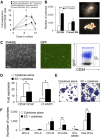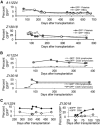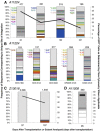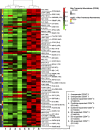Endothelial Cells Promote Expansion of Long-Term Engrafting Marrow Hematopoietic Stem and Progenitor Cells in Primates
- PMID: 28297579
- PMCID: PMC5442761
- DOI: 10.5966/sctm.2016-0240
Endothelial Cells Promote Expansion of Long-Term Engrafting Marrow Hematopoietic Stem and Progenitor Cells in Primates
Abstract
Successful expansion of bone marrow (BM) hematopoietic stem and progenitor cells (HSPCs) would benefit many HSPC transplantation and gene therapy/editing applications. However, current expansion technologies have been limited by a loss of multipotency and self-renewal properties ex vivo. We hypothesized that an ex vivo vascular niche would provide prohematopoietic signals to expand HSPCs while maintaining multipotency and self-renewal. To test this hypothesis, BM autologous CD34+ cells were expanded in endothelial cell (EC) coculture and transplanted in nonhuman primates. CD34+ C38- HSPCs cocultured with ECs expanded up to 17-fold, with a significant increase in hematopoietic colony-forming activity compared with cells cultured with cytokines alone (colony-forming unit-granulocyte-erythroid-macrophage-monocyte; p < .005). BM CD34+ cells that were transduced with green fluorescent protein lentivirus vector and expanded on ECs engrafted long term with multilineage polyclonal reconstitution. Gene marking was observed in granulocytes, lymphocytes, platelets, and erythrocytes. Whole transcriptome analysis indicated that EC coculture altered the expression profile of 75 genes in the BM CD34+ cells without impeding the long-term engraftment potential. These findings show that an ex vivo vascular niche is an effective platform for expansion of adult BM HSPCs. Stem Cells Translational Medicine 2017;6:864-876.
Keywords: Bone marrow transplantation; CD34+ cells; Endothelial cells; Gene therapy; Hematopoietic stem progenitor cell.
© 2016 The Authors Stem Cells Translational Medicine published by Wiley Periodicals, Inc. on behalf of AlphaMed Press.
Figures






Similar articles
-
Liver Sinusoidal Endothelial Cells Promote the Expansion of Human Cord Blood Hematopoietic Stem and Progenitor Cells.Int J Mol Sci. 2019 Apr 23;20(8):1985. doi: 10.3390/ijms20081985. Int J Mol Sci. 2019. PMID: 31018542 Free PMC article.
-
Promoting effects of serotonin on hematopoiesis: ex vivo expansion of cord blood CD34+ stem/progenitor cells, proliferation of bone marrow stromal cells, and antiapoptosis.Stem Cells. 2007 Jul;25(7):1800-6. doi: 10.1634/stemcells.2007-0048. Epub 2007 Apr 19. Stem Cells. 2007. PMID: 17446559
-
Ex-vivo expansion of nonhuman primate CD34+ cells by stem cell factor Sall4B.Stem Cell Res Ther. 2016 Oct 20;7(1):152. doi: 10.1186/s13287-016-0413-1. Stem Cell Res Ther. 2016. PMID: 27765075 Free PMC article.
-
Sources of Hematopoietic Stem and Progenitor Cells and Methods to Optimize Yields for Clinical Cell Therapy.Biol Blood Marrow Transplant. 2017 Aug;23(8):1241-1249. doi: 10.1016/j.bbmt.2017.05.003. Epub 2017 May 8. Biol Blood Marrow Transplant. 2017. PMID: 28495640 Review.
-
The role of granulocyte colony-stimulating factor in mobilization and transplantation of peripheral blood progenitor and stem cells.Cytokines Mol Ther. 1995 Dec;1(4):249-70. Cytokines Mol Ther. 1995. PMID: 9384679 Review.
Cited by
-
Evaluating Interaction of Cord Blood Hematopoietic Stem/Progenitor Cells with Functionally Integrated Three-Dimensional Microenvironments.Stem Cells Transl Med. 2018 Mar;7(3):271-282. doi: 10.1002/sctm.17-0157. Epub 2018 Feb 23. Stem Cells Transl Med. 2018. PMID: 29473346 Free PMC article.
-
Blood on the tracks: hematopoietic stem cell-endothelial cell interactions in homing and engraftment.J Mol Med (Berl). 2017 Aug;95(8):809-819. doi: 10.1007/s00109-017-1559-8. Epub 2017 Jul 13. J Mol Med (Berl). 2017. PMID: 28702683 Free PMC article. Review.
-
Molecular determinants of nephron vascular specialization in the kidney.Nat Commun. 2019 Dec 13;10(1):5705. doi: 10.1038/s41467-019-12872-5. Nat Commun. 2019. PMID: 31836710 Free PMC article.
-
Endothelial cells produce angiocrine factors to regulate bone and cartilage via versatile mechanisms.Theranostics. 2020 May 1;10(13):5957-5965. doi: 10.7150/thno.45422. eCollection 2020. Theranostics. 2020. PMID: 32483430 Free PMC article. Review.
-
Stromalized microreactor supports murine hematopoietic progenitor enrichment.Biomed Microdevices. 2018 Jan 20;20(1):13. doi: 10.1007/s10544-017-0255-3. Biomed Microdevices. 2018. PMID: 29353324 Free PMC article.
References
-
- Anguita‐Compagnon AT, Dibarrart MT, Palma J et al. Mobilization and collection of peripheral blood stem cells: Guidelines for blood volume to process, based on CD34‐positive blood cell count in adults and children. Transplant Proc 2010;42:339–344. - PubMed
-
- Perseghin P, Terruzzi E, Dassi M et al. Management of poor peripheral blood stem cell mobilization: Incidence, predictive factors, alternative strategies and outcome. A retrospective analysis on 2177 patients from three major Italian institutions. Transfus Apheresis Sci 2009;41:33–37. - PubMed
Publication types
MeSH terms
Substances
Grants and funding
LinkOut - more resources
Full Text Sources
Other Literature Sources
Medical

